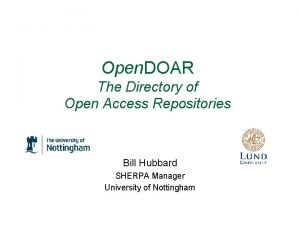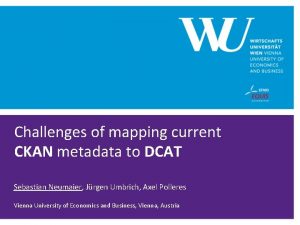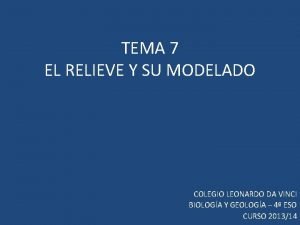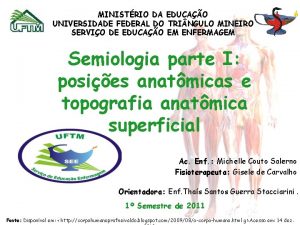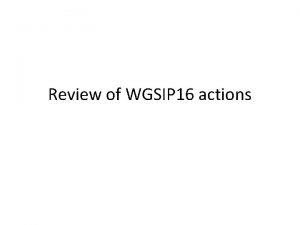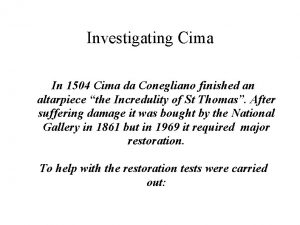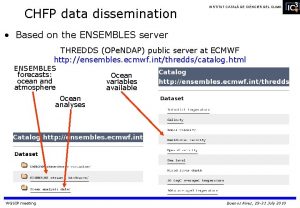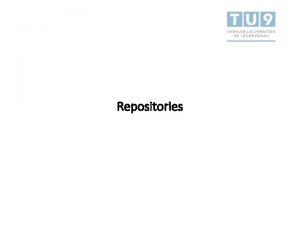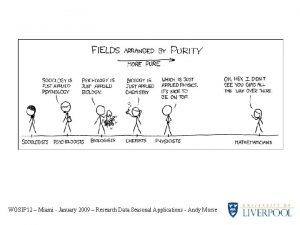Data repositories CHFP at CIMA is the WGSIP







- Slides: 7

Data repositories CHFP at CIMA is the WGSIP data repository: OPe. NDAP, web interface, Net. CDF 3, CHFP convention. Common complaint: Too many repositories (CHFP, EUROSIP, NMME, APCC, future S 2 S), different formats. From WCRP’s JSC: “Action 53: To consider WGSIP plan/decision on engagement in ESGF”. SPECS has adapted CMOR 2 (Climate Model Output Rewriter version 2) to the needs of the climate-prediction community. The documentation is now developed and available from the SPECS web site, but still awaiting PCMDI’s blessing. Initial tests will be available from BADC, one of the main nodes of ESGF. S 2 S’s data repository will follow the style from TIGGE (GRIB 2, based on MARS). To make the data ESGF-compliant, a technical solution for an ESGF node to be able to map the files and an onthe-fly convertor to the CMOR 2 Net. CDF format will be needed.

Moving from current CHFP format The current CHFP convention is not compatible with the CMOR and CF conventions. It also uses Net. CDF 3. The SPECS convention evolves from the CMIP 5 tables and uses the latest developments adopted by CORDEX: Net. CDF 4 (compression, half the size files), new experiment tables, double time axis, no ensemble dimension. Explicit paths, experiment names, rip standard: ECEARTH 3/sea. Ice. Clim. Init_series 2/S 19930501/mon/ocean/vo/r 1 i 1 p 1/vo_Omon_EC-EARTH 3_sea. Ice. Clim. Init_series 2_r 1 i 1 p 1_199305 -199308. nc CIMA will have to become an ESGF data node and convert all the current CHFP data.

Moving from current CHFP format Other differences with the CHFP format: slightly different time coordinates variables: double leadtime(time) ; leadtime: units = "days" ; leadtime: long_name = "Time elapsed since the start of the forecast" ; leadtime: standard_name = "forecast_period" ; double time(time) ; time: bounds = "time_bnds" ; time: units = "days since 1850 -01 -01" ; time: calendar = "gregorian" ; time: axis = "T" ; time: long_name = "Verification time of the forecast" ; time: standard_name = "time" ;

Moving from current CHFP format Other differences with the CHFP format: full description of grids variables: int j(j) ; j: units = "1" ; j: long_name = "cell index along second dimension" ; int i(i) ; i: units = "1" ; i: long_name = "cell index along first dimension" ; float lat(j, i) ; lat: standard_name = "latitude" ; . . . lat: bounds = "lat_vertices" ; float lon(j, i) ; lon: standard_name = "longitude" ; … lon: bounds = "lon_vertices" ; float lat_vertices(j, i, vertices) ; float lon_vertices(j, i, vertices) ;

Moving from current CHFP format Other differences with the CHFP format: full-flavour global attributes // global attributes: : institution = "IC 3" ; : experiment_id = "sea. Ice. Clim. Init" ; : realization = "1" ; : source = "EC-EARTH 3. 0. 1 official release from SMHI" ; : model_id = "EC-EARTH 3" ; : forcing = “CMIP 5 standard" ; : series = "series 2" ; : forecast_reference_time = "1993 -05 -01(T 00: 00 Z)" ; : physics_description = "N/A" ; : associated_model = "N/A" ; : initialization_description = "N/A" ; : initialization_method = 1 ; : physics_version = 1 ; : creation_date = "2014 -02 -06 T 16: 11: 42 Z" ; : tracking_id = "6 d 22 fb 21 -99 c 8 -4 a 8 b-b 4 c 5 -098 db 735 f 50 e" ; …

What next Obtain the official acceptance of PCMDI to this new convention (find a more appropriate name for it) and the incorporation of the SPECS patch. Assess the work required for CIMA to become an ESGF node. Prepare a convertor from current CHFP files to the new files (define values for the new attributes, experiment tables, one file per ensemble member). Also transfer the ENSEMBLES dataset. The size of the archive will be cut in half. Investigate with IRI the ability of the CPT to read the data from the current OPe. NDAP and the future ESGF node. Work with S 2 S to ensure that there is compatibility. A CMORcompatible GRIB 2 Net. CDF convertor will be needed. Lots of technical work, huge potential benefits visible in the shortterm, some funding required.

New projects WGSIP has three sub-projects under CHFP: Ice. HFP, Strat. HFP and GLACE 2. Other projects (e. g. S 2 S) are organised in science projects. Possible science projects relevant to WGSIP’s activities are: Teleconnections between tropics and extratropics Drift/initial shock and verification within the first month Others: climate services, verification, etc. They can all create synergies with S 2 S. How to proceed from here?
